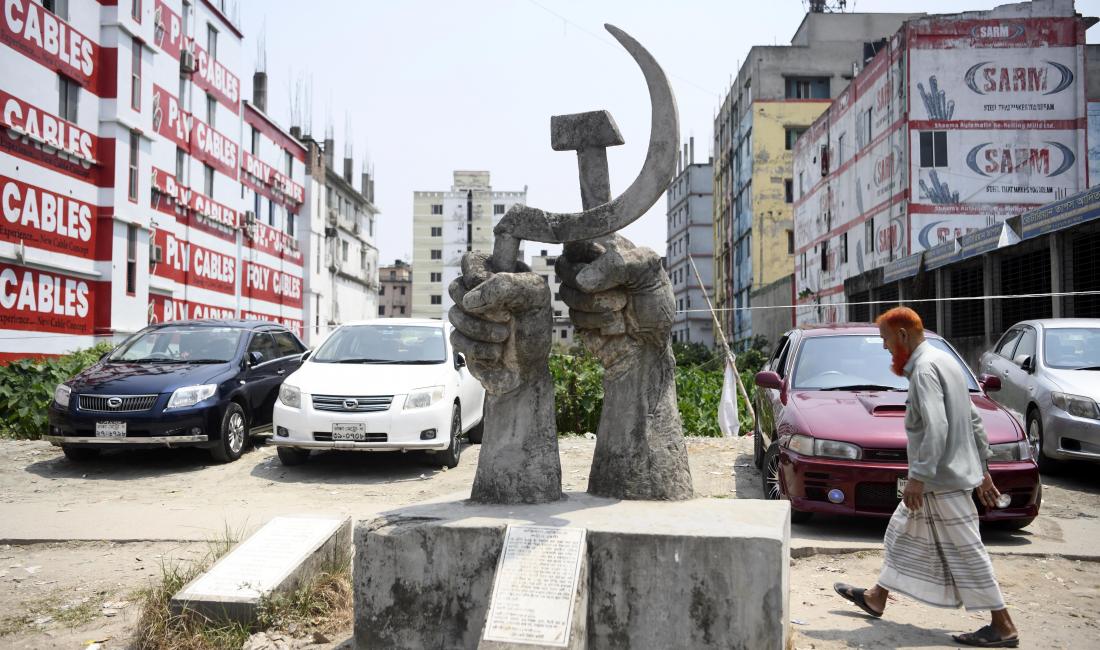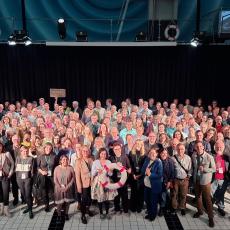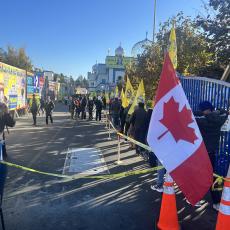Survivor's of Bangladesh's work industrial disaster are still waiting for justice
This essay was produced and published by Asia Democracy Chronicles. Photo credit: A monument to the victims of the Rana Plaza tragedy stands in front of the garment factory that collapsed on April 4, 2013. (Photo: Piyas Biswas)
Trapped for 18 hours under the mangled concrete and steel of the collapsed Rana Plaza garment factory in Dhaka, Bangladesh, Yanur Akhter remembers the darkness the most.
“When I was trapped under a concrete beam, there were four bodies on my left leg,” the former factory worker told Asia Democracy Chronicles (ADC). “I was not sure if they were alive or not. I was feeling suffocated, and I still suffer from asthma. It was so dark, I couldn’t tell if it was day or night. All I could hear were people crying and screaming for help.”
Akhter, now 27, was one of the survivors of the tragic incident. She managed to escape but ended up with severe nerve and spinal injuries. Her mother, who worked just one floor above her, did not make it out alive.
Twelve years have passed since that harrowing morning of April 24, 2013, when the eight-storey commercial building on the outskirts of the capital city crumbled, killing 1,134 and injuring at least 2,500.
For survivors like Akhter, time has not healed her wounds and justice remains elusive even if some reforms have been put in place to improve safety standards and step up factory management accountability since the Rana Plaza tragedy.
“After the accident, I am unable to go to work due to my injuries; I can’t do many of the house chores,” she said. “I don’t have any choice other than sitting at home with these injured legs.”
Today, Akhter lives in Savar in central Bangladesh with her husband, a day laborer, and their five-year-old son. Doctors had warned her that full recovery from the injuries sustained from the Rana disaster was impossible even after parts of her lower spine had to be surgically removed.
Stories of physical pain, joblessness, and abandonment – like Akhter’s – are all too familiar. Meanwhile, notwithstanding certain reforms, systemic challenges persist, prompting protests under the former administration that had put participating workers in the crosshairs of authorities.
Wake-up call
An investigation by the Bangladesh Anti-Corruption Commission pointed to a web of structural failures and corruption. It found, among others, that the building was built on swampy grounds and that substandard materials were used to construct its floors, totaling eight instead of four based on the building permit granted.
In 2017, the building’s owner and former ruling party official Sohel Rana was sentenced to three years in prison over charges of corruption that led to the collapse of his building. He also stands accused of murder for several deaths that resulted from the tragedy. The case remains unresolved. Rana was denied bail and still remains in prison.
In the wake of the collapse, Bangladesh’s garment industry, valued at $47 billion in 2023, faced unprecedented scrutiny over workplace safety and labor code violations. Almost 20 garment factories in Bangladesh were closed two weeks after the Rana Plaza collapse.
The ensuing international outrage led to the establishment of new safety frameworks, most notably the legally binding Bangladesh Accord in 2013, which was later expanded into the International Accord for Health and Safety in the Garment and Textile Industry.
The groundbreaking accord gave Bangladeshi unions more leverage and required signatory brands to remain contractually bound to improving safety conditions in supplier factories. It also prohibited companies from abandoning factories after unsafe structural conditions were flagged while requiring them to publish all inspection reports and remediation efforts for monitoring.
Then, too, the accord gave unions greater say in their workplaces as they advocate for worker benefits while holding fashion brands legally accountable for ensuring factories remained safe. Over 220 brands signed on to the original accord, which ran until 2018, when it was expanded into its current form.
Since the agreement took effect in 2013, more than 1,600 factories in Bangladesh have been declared safer for over 2.5 million workers, with only two brands hauled to court as of 2023 for alleged violations of the accord, according to the Clean Clothes Campaign group. In 2021, the New York Times reported that almost 200 factories with poor safety standards had lost contracts following accord-related investigations. The accord has a regulatory committee to decide safety conditions and run inspections.
Greener buildings, gray realities
The Rana Plaza tragedy also catalyzed a global movement toward greener and safer buildings thanks to the U.S. Green Building Council’s LEED (Leadership in Energy and Environmental Design) program, an internationally recognized green building rating system.
The program, which began well before the disaster, started gaining momentum after the plaza collapse: Only two factories in Bangladesh had earned a LEED certification in 2011. By 2025 that number jumped to 235.
“After the Rana Plaza incident in Bangladesh, there has been a massive transformation in our garment sector. Currently, we have 235 green factories in the country. It was after that incident that our mindset changed,” said Mohammad Hatem, president of the Bangladesh Knitwear Manufacturers and Exporters Association.
Garment industry officials began taking the urgent need to improve factory safety seriously as a raft of measures were put in place. But whether these proved adequate by the workers’ reckoning remained to be seen.
In 2024, more than a decade after the Rana Plaza collapse, the European Parliament passed a law that holds large companies and brands responsible for human rights violations or environmental abuses in their global supply chains. This has since prompted local industry associations in Bangladesh – including the Garment Makers Association – to set up hubs that would help companies transition to cleaner and fairer practices.
Crackdowns on protests
Despite these developments, which were deemed long overdue, progress remains mixed.
Babul Akhter, general secretary of the Bangladesh Garment and Industrial Workers Federation, said that while the program significantly improved structural safety in garment factories in Bangladesh, core issues like wage theft, occupational safety, and health hazards remain unresolved.
“The building structure and safety regulations changed. However, life did not change for the workers,” he said.
The country’s garment sector – comprising over 4,000 factories supplying brands like Levi’s, Zara, and H&M – still underpays and overworks its labor force, according to activists and watchdogs. At the same time, the country has yet to ratify crucial ILO conventions on workplace health, safety, and compensation.
In 2023, during the administration of the now-ousted Prime Minister Sheikh Hasina, tens of thousands of garment workers took to the streets to demand wage increases. This forced the government to raise the monthly minimum wage from 8,000 BDT ($75) to 12,500 BDT ($113), which many say was still too small.
“The average worker salary is still very low; factory owners claim buyers are unwilling to increase it, whereas buyers say they communicate with the owners about the wage structure,” said Akhter. “Eventually, this endless loop results in no change in the workers’ lives.”
Garment workers’ demands granted by the government came at a cost while impunity for human rights abuses committed against this sector reigned long after the rubble from the Rana collapse had been cleared.
According to Amnesty International, protests sparked by unpaid wages and demands for higher wages in 2023 led to the filing of at least 35 criminal cases against garment workers. Of these, 25 were lodged by factories believed to be suppliers of major international brands.
An estimated 35,900 to 44,450 workers were also accused of participating in the protests, allowing factories to intimidate workers with threats of dismissal, the report said.
In October 2023, the Konabari Police Station in Gazipur in central Bangladesh charged eight named workers and 2,500 to 3,000 unnamed ones with specific crimes such as unlawful assembly and assault. Police used 215 shotgun rounds, 127 tear gas shells, and 52 sound grenades to disperse protesters. Six officers were injured in the clashes.
Rights groups said these incidents reinforce the widespread perception in the garment sector that basic labor rights and protections remain alarmingly weak despite improved building safety for workers.
“In addition to the lack of justice, most workers today are still fighting for decent wages in an industry that brings the most revenue to Bangladesh and paying a heavy price for fighting for their rights,” said Amnesty International deputy regional director Nadia Rahman.
Endless nightmare
“The lives of the injured workers have truly become unbearable,” said Joly Talukder, vice president of the Garment Workers Trade Union Centre. “Those who lost limbs received a one-time payment. But many others suffered injuries no less severe … they can’t even do regular work.”
Talukder said the government had deposited 127 crore BDT ($10.4 million) in the Prime Minister’s Relief Fund, but only 22 crore BDT ($1.7 million) was disbursed. “We don’t know where the rest of the money is.”
The Fund was set up to assist individuals and communities affected by natural and man-made disasters.
“I only received a total of 45,000 BDT ($370) after the incident; I don’t know if it’s compensation, help, or charity,” said Parul Begum. “It was better not to give me anything rather than shaming me with this.”
She was trapped under the rubble for eight hours when the Rana building collapsed. A metal rod pierced her side, damaging her right kidney.
She no longer hopes for rehabilitation or restitution. “I don’t even want compensation now or rehabilitation. It’s better to end this suffering of a life. There are no other ways for me anymore.”
Meanwhile, Talukder is still appealing for support for Rana survivors struggling with permanent disabilities. “We’re continuing to ask that something be done for them so they can live out the rest of their lives with dignity and not in prolonged suffering.”



